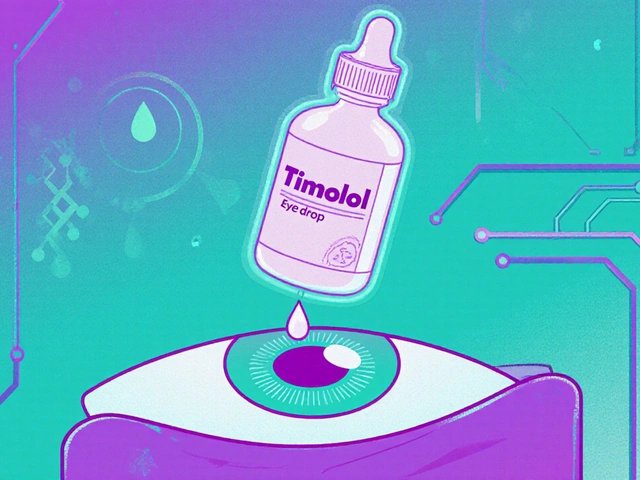
Opioid Risk Assessment Tool
Personalized Risk Assessment
This tool calculates your personalized risk level for opioid monitoring based on the standard Opioid Risk Tool (ORT). Your results will help determine appropriate testing frequency and strategies.
Why Urine Drug Screens Are a Normal Part of Opioid Treatment
When you’re on long-term opioid therapy for chronic pain, your doctor isn’t just checking if you’re taking your meds-they’re trying to keep you alive. Urine drug screens aren’t about suspicion. They’re a tool to catch hidden dangers before they become emergencies. In 2021, over 80,000 deaths in the U.S. involved opioids, and many of those cases included drugs the patient wasn’t prescribed-like fentanyl or heroin. A simple urine test can reveal those hidden risks. It’s not about punishment. It’s about prevention.
How Urine Tests Actually Work (And Where They Fall Short)
Most clinics start with an immunoassay screen, a cheap and fast method that costs about $5 per test. It’s like a smoke detector: it goes off if something’s wrong, but it doesn’t tell you what’s burning. These tests can give false positives from common medicines like ibuprofen or cold pills, and they often miss fentanyl entirely because its chemical structure doesn’t trigger the standard opiate detectors. That’s a huge problem-fentanyl is 50 times stronger than heroin, and patients on patches or lozenges can test negative even when they’re taking their medication exactly as prescribed.
When a screen comes back odd, labs use gas chromatography/mass spectrometry (GC/MS) or liquid chromatography/mass spectrometry (LC-MS) to confirm. These tests cost $25 to $100, take longer, and are far more accurate. They can tell you exactly which drug is in the system-even metabolites you didn’t know existed. But here’s the catch: many clinics don’t do confirmatory tests unless something looks wrong. That means patients taking hydrocodone regularly might get flagged as non-adherent because the immunoassay misses it 72% of the time. One patient on Reddit said they failed a test despite taking their oxycodone daily. Turns out, the test just couldn’t see it.
What Drugs Are Hard to Detect-and Why It Matters
Not all opioids are created equal when it comes to testing. Methadone shows up clearly in most screens, with over 95% sensitivity. But hydrocodone? It’s practically invisible to standard opiate panels. That’s why so many doctors are now switching to broader panels that specifically include hydrocodone and hydromorphone. Fentanyl is another silent threat. Until 2023, nearly every routine urine test missed it. Now, the FDA has approved a new fentanyl-specific immunoassay with 98.7% sensitivity. But it’s not widely used yet. Many clinics still rely on outdated panels.
Synthetic cannabinoids like Spice or K2 also slip through. Standard marijuana tests won’t catch them, and patients using these substances are at higher risk of overdose. Stimulants like Adderall or Ritalin can trigger false positives for amphetamines, leading to unnecessary alarm. Even buprenorphine, used to treat opioid addiction, can cause false positives on some screens, leading to patients being wrongly accused of relapse. The bottom line: a negative result doesn’t mean you’re not taking your medicine. It might just mean the test is outdated.

How Risk Stratification Changes Everything
Testing everyone the same way doesn’t make sense. A 68-year-old with arthritis on low-dose oxycodone isn’t the same risk as a 32-year-old with a history of substance use disorder on high-dose morphine. That’s why the Opioid Risk Tool (ORT) is now standard in most clinics. It’s a five-question form that asks about family history, personal substance use, age, psychological conditions, and prior misuse. Based on the answers, patients are grouped as low, moderate, or high risk.
Low-risk patients might only need a urine test once a year. Moderate-risk patients get tested every six months. High-risk patients? Quarterly tests, with specimen validity checks to make sure the sample hasn’t been diluted or swapped. This isn’t just theory-it’s practice. One clinic in Arizona saw a 37% drop in lost prescriptions after switching to risk-based testing. The CDC and American Medical Association now recommend this tiered approach. Universal screening is expensive, inefficient, and sometimes harmful. Targeted screening saves money and saves lives.
What Clinicians Get Wrong (And How to Avoid It)
Many doctors misinterpret test results because they weren’t trained to. A negative result for hydrocodone? That doesn’t mean the patient stopped taking it. It might mean the test panel doesn’t include it. A positive for benzodiazepines? Could be a prescribed sleep aid, not recreational use. A diluted sample? Could be from drinking too much water before the test-not necessarily an attempt to cheat.
Specimen validity checks are critical. If the urine is too dilute (specific gravity below 1.003), too alkaline (pH above 9.0), or has low creatinine (under 20 mg/dL), it’s not a valid sample. Most labs check this automatically, but not all providers understand what it means. A 2019 study found that 30% of urine tests ordered in pain clinics were clinically inappropriate-ordered without reason, or interpreted incorrectly. That’s not just wasted money; it’s eroding trust between patients and providers.
Training matters. Clinicians need at least 8-12 hours of specialized education to interpret results correctly. Without it, they might punish someone for a false negative or mislabel a legitimate medication as abuse. The goal isn’t to catch people lying-it’s to understand what’s really happening in their body.

The Business Behind the Test
The urine drug testing market hit $3.1 billion in 2022 and is growing fast. Why? Because 38 U.S. states now legally require testing for patients on high-dose opioids. Medicare alone processed nearly 39 million tests in 2022. Five major labs-Quest Diagnostics, LabCorp, BioReference, Aegis Sciences, and Millennium Health-control 87% of the market. Reimbursement varies: basic immunoassays get paid around $20, while full LC-MS panels can bring in over $100.
But cost doesn’t always mean quality. Some clinics stick with cheap tests to save money, even when they’re missing key drugs. Others use expensive confirmatory tests for everyone, driving up costs unnecessarily. The smart approach? Use low-cost screening for low-risk patients, and reserve confirmatory testing for high-risk cases or suspicious results. It’s not about spending more-it’s about spending smarter.
What’s Next for Opioid Monitoring
The future of opioid monitoring is getting smarter. In late 2024, updated CDC guidelines are expected to push for LC-MS testing for anyone on fentanyl or other synthetic opioids. New point-of-care devices are in FDA review-devices that could give lab-quality results in under an hour, right in the clinic. Artificial intelligence tools like the University of Pittsburgh’s Opioid Adherence Prediction Engine are being tested to predict who’s at risk of misuse before it happens, based on patterns in test results, refill behavior, and even appointment attendance.
But the biggest change might be cultural. More providers are starting to see urine tests not as a way to catch patients doing something wrong, but as a way to understand what’s going on in their lives. A positive for cocaine might mean someone’s using to cope with uncontrolled pain. A missed dose might mean they can’t afford their medication. The test doesn’t tell the whole story-but it gives you the right question to ask.
What Patients Should Know
If you’re on long-term opioids, expect a urine test. It’s not personal. It’s standard. Ask your provider: Which drugs are you testing for? Will you confirm positives with a more accurate test? What’s my risk level, and how often will I be tested? If your prescribed medication keeps showing up negative, push for a more detailed panel. Don’t assume the test is wrong-assume the test is incomplete.
And if you’re worried about being judged? Remember: most patients on opioids are taking them as directed. The people who misuse are the minority. The system is designed to protect you-not to punish you.
Why does my hydrocodone keep showing up as negative on my urine test?
Many standard urine drug screens don’t detect hydrocodone because they’re designed to catch morphine-like opioids. Hydrocodone has a different chemical structure, and most immunoassays miss it up to 72% of the time. If your test says negative but you’re taking your medication as prescribed, ask your provider to order a more specific panel that includes hydrocodone and hydromorphone. Confirmatory testing with GC/MS or LC-MS can give you a definitive answer.
Can fentanyl be detected in a routine urine test?
Until 2023, most routine urine tests couldn’t detect fentanyl because it doesn’t trigger the standard opiate detectors. Even patients on fentanyl patches or lozenges often tested negative. A new fentanyl-specific immunoassay was approved by the FDA in 2023 with 98.7% sensitivity. But many clinics still use older panels. If you’re on fentanyl, ask your provider if your test includes a fentanyl-specific screen. Otherwise, request a confirmatory LC-MS test.
Does a positive test for benzodiazepines mean I’m misusing my medication?
Not necessarily. Benzodiazepines like lorazepam or clonazepam are often prescribed for anxiety, insomnia, or muscle spasms. A positive result could mean you’re taking your prescribed medication, not using something illicit. Always tell your provider about all medications and supplements you’re taking. If you’re unsure why a drug shows up, ask for a confirmatory test to identify the exact compound.
How often should I be tested if I’m on long-term opioids?
It depends on your risk level. The Opioid Risk Tool (ORT) classifies patients as low, moderate, or high risk. Low-risk patients typically need testing once a year. Moderate-risk patients should be tested every six months. High-risk patients-those with a history of substance use, mental health conditions, or high-dose prescriptions-should be tested quarterly. Random testing is more effective than scheduled testing because it reduces the chance of manipulation.
Can I be punished for a positive test for an illicit drug?
Some clinics may reduce or stop opioid prescriptions after a positive test, but that’s not always the right response. A positive result might indicate a co-occurring disorder, unmanaged pain, or lack of access to addiction treatment. The goal of testing isn’t punishment-it’s intervention. If you test positive for an illicit substance, ask for a referral to counseling or medication-assisted treatment. Many providers now use positive results as a trigger for support, not termination of care.
Are there alternatives to urine testing for opioid monitoring?
Blood tests are rarely used because they only show recent use and are more invasive. Hair testing can detect drug use over months but doesn’t show current use or recent changes. Saliva tests are emerging but aren’t yet reliable for opioids. For now, urine remains the gold standard because it’s noninvasive, affordable, and can detect a wide range of substances over several days. New point-of-care devices are in development and may change this in the next few years.




